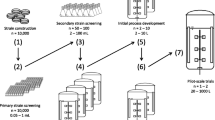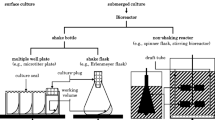Abstract
Respiration measurement is applied as a universal tool to determine the activity of biological systems. The measurement techniques are difficult to compare, due to the vast variety of devices and analytical procedures commonly in use. They are used in fields as different as microbiology, gene engineering, toxicology, and industrial process monitoring to observe the physiological activity of living systems in environments as diverse as fermenters, shake flasks, lakes and sewage plants. A method is introduced to determine accuracy, quantitation limit, range and precision of different respiration measurement devices. Corynebacterium glutamicum cultures were used to compare an exhaust gas analyzer (EGA), a RAMOS device (respiration measurement in shake flasks) and a respirometer. With all measuring devices it was possible to determine the general culture characteristics. The EGA and the RAMOS device produced almost identical results. The scatter of the respirometer was noticeably higher. The EGA is the technique of choice, if the reaction volume is high or a short reaction time is required. The possibility to monitor cultures simultaneously makes the RAMOS device an indispensable tool for media and strain development. If online monitoring is not compulsive, the respiration of the investigated microbial system extremely low, or the sample size small, a respirometer is recommended.



Similar content being viewed by others
References
Anderlei T, Büchs J (2001) Device for sterile online measurement of the oxygen transfer rate in shaking flasks. Biochem Eng J 7:157–162
Stöckmann C, Maier U, Anderlei T, Knocke C, Gellissen G, Buechs J (2003) The oxygen transfer rate as key parameter for the characterization of Hansenula polymorpha screening cultures. J Ind Microbiol Biotechnol 30:613–622
Büchs J, Maier U, Milbradt C, Zoels B (2000) Power consumption in shaking flasks on rotary shaking machines: II nondimensional description of specific power consumption and flow regimes in unbaffled flasks at elevated liquid viscosity. Biotechnol Bioeng 68:594–601
Anderlei T, Zang W, Papaspyrou M, Büchs J (2004) Online respiration activity measurement (OTR, CTR, RQ) in shake flasks. Biochem Eng J 17:187–194
Silberbach M, Maier B, Zimmermann M, Büchs J (2003) Glucose oxidation Gluconobacter oxydans: characterization in shaking-flasks, scale-up and optimization of the pH profile. Appl Microbiol Biotechnol 62:92–98
Stöckmann C, Losen M, Dahlems U, Knocke C, Gellissen G, Büchs J (2003) Effect of oxygen supply on the passaging, stabilizing and screening of recombinant Hansenula polymorpha production strains in test tube cultures. FEMS Yeast Res 4:195–205
Raval KN, Hellwig S, Prakash G, Ramos-Plasencia A, Srivastava A, Büchs J (2003) Necessity of a two-stage process for the production of azadirachtin-related limonoids in suspension cultures of Azadirachta indica. J Biosci Bioeng 96:16–22
Wittmann C, Kim HM, John G, Heinzle E (2003) Characterization and application of an optical sensor for quantification of dissolved O2 in shake-flasks. Biotechnol Lett 25:377–380
Boyles DT (1978) Specific growth rate measurement in an oxygen electrode chamber. Biotechnol Bioeng 20:1101–1104
Ridgway HF (1977) Source of energy for gliding motility in Flexibacter polymorphus: effects of metabolic and respiratory inhibitors on gliding movement. J Bacteriol 131:544–556
Wittmann C, Yang T, Kochems I, Heinzle E (2001) Dynamic respiratory measurements of Corynebacterium glutamicum using membrane mass spectrometry. J Microbiol Biotechnol 11:40–49
Montagnolli W, Zamboni A, Luvizotto-Santos R, Yunes JS (2004) Acute effects of Microcystis aeruginosa from patos lagoon estuary, southern Brazil, on the microcrustacean Kalliapseudes schubartii (Crustacea: Tanaidacea). Arch Environ Contam Toxicol 46:463–469
Frost MT, Wang Q, Moncada S, Singer M (2005) Hypoxia accelerates nitric oxide-dependent inhibition of mitochondrial complex I. In activated macrophages. Am J Physiol Regul Integr Comp Physiol 288:394–400
Lee YH, Tsao GT (1979) Dissolved oxygen electrodes. Adv Biochem Eng Biotechnol 13:35–86
Kohls O, Scheper TH (2000) Setup of a fiber optical oxygen multisensor-system and its application in biotechnology. Sens Actuators 70:121–130
Kinoshita S, Udaka S, Shimono M (1957) Amino acid fermentation. I. Production of l-glutamic acid by various microorganisms. J Gen Appl Microbiol 3:193–205
Chamsartra S, Hewitt CJ, Nienow AW (2005) The impact of fluid mechanical stress on Corynebacterium glutamicum during continuous cultivation in an agitated bioreactor. Biotechnol Lett 27:693–700
Seletzky JM, Noack U, Fricke J, Hahn S, Büchs J (2006) Metabolic activity of Corynebacterium glutamicum grown on l-lactic acid under stress. Appl Biotechnol Bioeng (published online). DOI:10.1007/s00253-006-0436-0
Maier B, Dietrich C, Büchs J (2001) Correct application of the sulphite oxidation methodology of measuring the volumetric mass transfer coefficient kLa under non-pressurized and pressurized conditions. Trans IChemE 79:Part C
Maier U, Büchs J (2001) Characterization of the gas–liquid mass transfer in shaking bioreactors. Biochem Eng J 7:99–106
Schumpe A, Deckwer WD (1979) Estimation of O2 and CO2 solubilities in fermentation media. Biotechnol Bioeng 21:1075–1078
Schumpe A, Quicker G, Deckwer WD (1982) Gas solubilities in microbial culture media. Adv Biochem Eng 48:1–38
Rischbieter E, Schumpe A (1996) Gas solubilities in aqueous solutions of organic substances. J Chem Eng Data 41:809–812
Int. Conf. Harmonization tech. Requirements reg. Pharmaceuticals Human use (ICH) (1996) Guidance for industry Q2B Validation of analytical procedures
Cocaign M, Monnet C, Lindley ND (1993) Batch kinetics of Corynebacterium glutamicum during growth on various carbon substrates: use of mixtures to localize metabolic bottlenecks. Appl Microbiol Biotechnol 40:526–530
Cocaign-Bousquet M, Guyonvarch A, Lindley ND (1996) Growth rate-dependent modulation of carbon flux through central metabolism and the kinetic consequences for glucose-limited chemostat cultures of Corynebacterium glutamicum. Appl Environ Microbiol 62:429–436
Cocaign-Bousquet M, Lindley ND (1995) Pyruvate overflow and carbon flux within the central metabolic pathways of Corynebacterium glutamicum during growth on lactate. Enzyme Microb Technol 17:260–267
Enfors SO, Mattiasson B (1983) Oxygenation of processes involving immobilized cells. In: Mattiasson B (ed) Immobilized cells and organelles. CRC Press, Boca Raton, FL, pp 41–60
Kennedy MJ, Reader SL, Davies J, Rhoades DA, Silby HW (1994) The scale up of myceleal shake flask fermentations: a case study of gamma linolenic acid production by Mucor hiemalis IRL 51. J Ind Microbiol 13:212–216
Acknowledgments
We thank Dipl.-Ing. Karen Otten and Prof. Dr.-Ing. Horst R. Maier, Institute for Ceramic Components in Mechanical Engineering, RWTH Aachen University and Silvia Denter for their help and advice. This work was supported by a grant from the German Research Foundation (DFG).
Author information
Authors and Affiliations
Corresponding author
Rights and permissions
About this article
Cite this article
Seletzky, J.M., Noack, U., Hahn, S. et al. An experimental comparison of respiration measuring techniques in fermenters and shake flasks: exhaust gas analyzer vs. RAMOS device vs. respirometer. J Ind Microbiol Biotechnol 34, 123–130 (2007). https://doi.org/10.1007/s10295-006-0176-2
Received:
Accepted:
Published:
Issue Date:
DOI: https://doi.org/10.1007/s10295-006-0176-2




